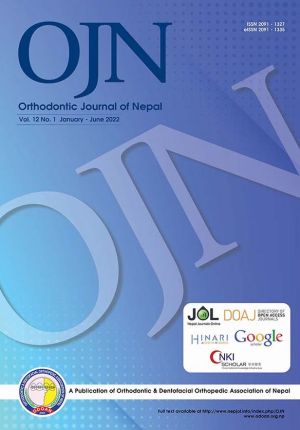Finite Element Study to Compare Stress Distribution and Displacement in the Palatal Implant in Lingual Orthodontics in Four Different Combinations of Palatal Implant and Lever Arm
DOI:
https://doi.org/10.3126/ojn.v12i1.47481Keywords:
En-mass retraction, Finite element analysis, Lingual orthodontics, Palatal implants, Von Mises stressAbstract
Introduction: The choice of orthodontic appliance depends upon the patients age, profession and availability of them. Lingual orthodontic appliances are preferred over labial by patients because of its invisibility. The aim of this research is to compare the Von Mises stress distribution and displacement of palatal implants in the lingual orthodontic system among four different combinations of palatal implant and lever arm.
Materials and Method: Four Finite element models were constructed for the bilaterally extracted first premolar maxillary arch. In all these models 0.018” slot lingual brackets were placed at the center of the clinical crown. A similar retraction force (150gm) was applied with the help of NiTi closed coil spring for all the models but the length of the lever arm vary as well as the palatal implant position also varies in these models. Finite element analysis was then performed to compare the Von Mises stress distribution, and displacement of the palatal implant using ANSYS 12.1 software.
Result: In this study, displacement was the same (0.0005 mm) for all four models. Highest amount von mises stress was observed in Model 3 (3.4798 MPa) as a comparison to Model 1 (2.5442 MPa), Model 2 (2.5018 MPa), and Model 4 (3.3854 MPa). The stress value for the palatal implant was within the acceptable fatigue limit of the titanium of 193 MPa therefore all four models combination was safe for the clinical application.
Conclusion: Double palatal implant systems were more effective in comparison to the single palatal implant system in lingual orthodontics. In this study, we found that the displacement of the palatal implants was not affected by the length of the lever-arm and the amount of stress was decreased when we increase the length of the lever-arm.
Downloads
Downloads
Published
How to Cite
Issue
Section
License
Copyright (c) 2022 Orthodontic & Dentofacial Orthopedic Association of Nepal

This work is licensed under a Creative Commons Attribution 4.0 International License.
Copyright © held by Orthodontic & Dentofacial Orthopedic Association of Nepal
- Copyright on any research article is transferred in full to the Orthodontic & Dentofacial Orthopedic Association of Nepal upon publication in the journal. The copyright transfer includes the right to reproduce and distribute the article in any form of reproduction (printing, electronic media or any other form).
- Articles in the Orthodontic Journal of Nepal are Open Access articles published under the Creative Commons CC BY License (https://creativecommons.org/licenses/by/4.0/)
- This license permits use, distribution and reproduction in any medium, provided the original work is properly cited.




